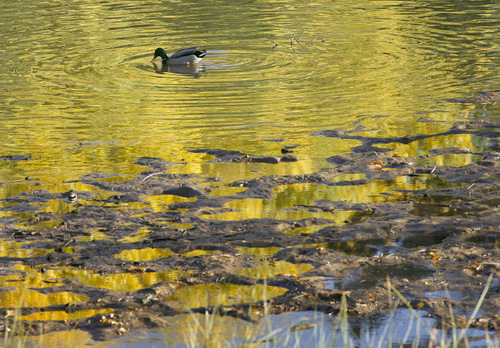This is an archived article that was published on sltrib.com in 2010, and information in the article may be outdated. It is provided only for personal research purposes and may not be reprinted.
Federal regulators want to slap Chevron Pipe Line Co. with a $423,600 fine for the June 11-12 spill that leaked 33,600 gallons of crude oil into Salt Lake City waterways.
The U.S. Department of Transportation's Pipeline and Hazardous Materials Safety Administration announced the proposed fine Monday, nearly five months after the Red Butte Creek spill.
The agency also ordered the oil giant to beef up the pipeline's safety with better inspections, leak detection and electric-charge protections.
"The department's top priority is safety," U.S. Transportation Secretary Ray LaHood said in a news release, "and we remain committed to ensuring America's pipelines are capable of safely delivering vital energy products to U.S. households and businesses."
But Yalecrest resident Peter Hayes, calling himself a "spill survivor," denounced the federal fine as "ridiculously low." He said the accident required a sum at least 100 times greater to deter the company from repeating the same mistakes.
"The potential for catastrophe and loss of life is huge with that kind of spill," Hayes said, insisting that the best response would be to relocate the pipeline (which is back in operation).
Chevron workers have been cleaning up the sticky oil ever since the accident. They were expected to mobilize crews Monday as the city started draining Liberty Park's pond, which acted as a kind of catch basin to keep the oil in Red Butte Creek from further contaminating the Jordan River downstream.
The company's investigation determined that a lightning strike sparked an electrical arc, blasting a small hole in the 60-year-old pipeline near Red Butte Garden in the foothills east of Salt Lake City.
While the pipeline safety office agreed the puncture caused the leak, it also said Chevron could have done more to prevent the breach.
The federal probe noted the company's use of aerial patrols to monitor the pipeline's path failed to notice possible problems. It also pointed to inadequate corrosion control, a failure to shield the pipeline from stray electrical currents and a poor leak-detection system.
Chevron did not know about the ruptured Red Butte line until it received a call from the Salt Lake City Fire Department. By that time, according to the pipeline safety office, crude oil had been leaking for more than 10 hours.
Chevron has 30 days to challenge the federal fine and prescription for fixing the problems. At this point, it is not clear whether the company will do so.
Spokesman Dan Johnson said Chevron would have no comment until it has an opportunity to examine the notice of violation and the compliance order.
"We haven't been able to see the order," he said. "We haven't been able to review the findings."
The federal office shares with its state counterparts oversight duties for the nation's 2.5 million miles of pipelines transporting crude oil, natural gas, jet fuel, kerosene and other hazardous liquids, as well as the 3,000 companies that operate those lines.
City and state officials generally have supported Chevron's post-spill cleanup efforts.
"We believe Chevron and other oil companies will see the ... [federal] fine as a warning to take appropriate actions to better safeguard our communities from future disasters like June's oil spill in Red Butte Creek," Salt Lake City Mayor Ralph Becker said. "We take seriously our role as watchdog of the cleanup process and continue our negotiations with Chevron for additional restitution plans and efforts to restore our community."
The city has hired an environmental-consulting company to advise on Chevron's response. Air-quality consultants and a toxicology expert also have been retained.
So far, the city has incurred $372,275 in spill-related costs (Chevron has repaid about $221,518 of that) and the state has billed the company about $222,800.
The Utah Division of Water Quality has yet to take up the question of fines, said agency director Walt Baker. In July, the state issued a notice of violation against Chevron for three breaches to the Utah Water Quality Act.
The state asked Chevron last month for clarification on several points, Baker said, and the responses will help the state decide on penalties.
"We are not even at that stage yet," he said. We're still fact finding."
Federal findings in Red Butte spill
Aerial patrols of pipeline rights of way failed to address "excessive overgrowth and nearby manmade structures." The notice of violation said: "Heavy vegetation, numerous structures and narrow canyons in this pipeline segment indicate that aerial patrols could not be used to adequately assess the surface conditions on or adjacent to the pipeline right of way."
Proposed penalty: $45,400
Chevron did not have proper grounding devices on underground pipelines to reduce the risk of fault currents, lightning and electrical arcing — even with an electrical transfer station nearby. "This lack of protection resulted in a hole being created in the pipeline due to electrical arcing from the facility fence pole."
Proposed penalty: $316,600
The company did not have adequate leak detection at the time of the June spill. The pipeline safety office noted Chevron had determined in 2007 that better leak detection was needed but never made the improvements.
Proposed penalty: $61,600
A fence post was installed within 3 inches of the pipeline although regulations require at least 12 inches. "The probable cause of the pipeline failure on June 11, 2010, was a high-voltage electrical current, which went from the fence post to the pipeline due to the proximity of the post to the pipeline," inspectors said.
Proposed penalty: $0



